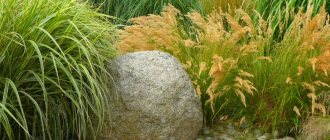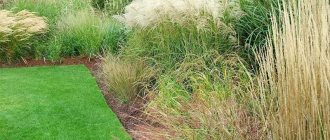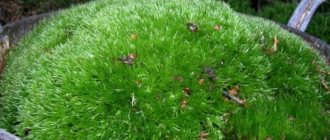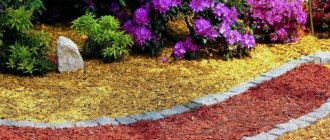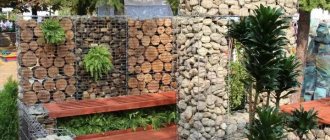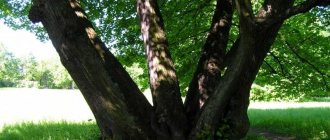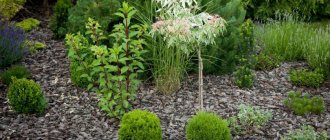Reeds (from Latin Scírpus) are perennial or annual crops, which belong to the Sedge family, living primarily in the aquatic environment. Probably every person has encountered a reed at least once in his life and represents this plant. However, not everyone knows that the plant has varieties that are grown in the garden as an ornamental plant. In addition, reeds contain beneficial properties that are also unknown to many people.
Use of reeds, interesting facts
This plant is used to decorate gardens in a natural style. It complements the plant compositions of shallow waters. Reeds are an excellent background for spectacular water lilies, egg capsules and other plants that float on the water surface. Shady gardens are also decorated with certain types of reeds. It often forms an impenetrable wall of stems, resembling a two-meter hedge. Pollen from inflorescences is transferred from one plant to another by the wind. It is very useful for reservoirs, because it prevents water pollution.
Reed is good because it is used to weave shopping bags, baskets, mats, and rugs. They decorate wickerwork made from wicker. The leaves are used the most. For green products they are cut in July, and for yellow ones - in September. To keep them elastic, dry them in the shade. Sometimes used as fuel. In the 20th century, it was used to make reed concrete for rural construction.
The plant was used not only by Russians, but also by other peoples. The British used it to insulate castles and huts. It made the air dry. Reed thickets were a favorite place for hunters, because wild birds loved to hide there.
Reeds were also popular among the Egyptians. The Old Testament says that the prophet Moses was found in a reed wicker basket. And in many myths, babies were saved in just such a wicker basket. The Romans sent the children Romulus and Remus (the founders of Rome) across the water in a similar container made of reeds. One of the hymns to the god of death Yama mentions a reed flute.
In Central Asia, the plant was added to make gypsum. It was excellent for the construction of building floors in seismically hazardous areas. In Russia it was used as thermal insulation. In pre-revolutionary times, special reed slabs were made and installed in the walls of railway cars.
Home care
Can I keep it at home?
For a long time in Rus' there was a sign that swamp reeds should not be kept in the house, as they attract misfortune, illness and death.
However, there are other opinions about reeds. For example, the inhabitants of Ancient Egypt associated this plant with power, because it grew only near bodies of water, which were of great value for an arid country. And dry reeds placed near the entrance to the home helped scare away ill-wishers.
From a medical point of view, marsh reeds can be dangerous after fading , as they begin to disintegrate into tiny fluff, which can trigger allergic reactions. In addition, reeds brought from the swamp may bear traces of the vital activity of various animals that are carriers of dangerous diseases.
IMPORTANT! There are decorative reeds that are specially created for growing at home.
Trimming
Reed is an unpretentious plant , but it is prone to very rapid growth , and therefore requires regular pruning with pruners to form a beautiful shape.
Pruning is best done in late autumn. Both overgrown roots and wilted leaves are pruned.
Watering
Since reed is a marsh plant, it loves humidity very much . In this regard, it is recommended to water it abundantly.
In the cold season, watering the reeds is slightly reduced, but the top layer of soil in which this representative of the flora grows should not be allowed to dry out. For irrigation you should use settled soft water . Once every three days, reed leaves must be irrigated with water.
Landing
It is usually planted on a swampy bank or directly into the reservoir itself. Types of reeds with stems covered with leaves are immersed in water by twenty centimeters when planting, and reeds with bare stems - by a meter.
Decorative species are used for coastal landscaping. When planting reeds at home, you should choose a shallow, wide container.
Transfer
Reeds are characterized by rapid aging and shedding of leaves .
For this reason, the plant requires replanting every spring. During transplantation, the reeds are separated and yellowed leaves are removed.
IMPORTANT! You should not divide the reeds into too many parts, since weak roots on small bushes may not take root.
Temperature
In summer, the most favorable temperature for reeds is considered to be a temperature not exceeding twenty degrees Celsius, and in winter it is necessary to ensure that it does not fall below eight degrees. Although reed is a cold-resistant plant that can withstand temperatures of five degrees above zero, it still prefers warmth.
Lighting
The reed will feel most comfortable in illuminated areas, but it does not tolerate direct sunlight. The most favorable place for it is considered partial shade.
Growing from seeds at home
The process of growing reeds from seeds is quite labor-intensive.
The seeds must first be wet stratified at low temperatures above freezing for two months. It is best to plant them in February or March.
The seeds are distributed over the surface of moist soil, consisting of a mixture of sand, peat and humus in equal parts. To maintain soil and air moisture, it is recommended to cover the seed container with glass and place it on a tray filled with water.
The temperature in the room where the seeds are located should be between seventeen and twenty degrees Celsius.
After five to seven days, you will notice the emergence of seedlings, which will need to be pruned after a couple of months. In June, young reeds must be planted in a permanent place.
Reproduction
Since when reeds are propagated by seeds, their varietal characteristics are lost, these plants are most often propagated by dividing the root system. One bush can be divided into seven parts using pruners, each of which must have at least one bud and developed roots.
The parts obtained as a result of division are immediately planted in the ground. The distance between them should be at least forty centimeters.
Bloom
The flowering period of reeds begins at the end of June or early July.
Ground, soil
Reeds will feel best in moist neutral or slightly acidic soil , the pH level of which is from 5.0 to 7.0.
Fertilizer
Reeds must be fed with mineral fertilizers , the proportion of which should be one gram per meter. Most often, compost, humus or wood ash are added to the soil. In moderate quantities, it is allowed to feed the reeds with potassium salt and superphosphate.
In the first months of spring, it is recommended to enrich the soil with urea, and in order for the plant to grow and develop properly, it must be fed every month with fertilizers that do not contain calcium.
Bulbous ryegrass
Small striped bushes of bulbous ryegrass are loved by designers for their easy shaping and low aggressiveness. They spread much less than most grains, they can be given any shape, and after a couple of weeks after cutting to zero, they turn green again.
Caring for ryegrass is simple: it is cut three times a season, fed with diluted compost once a year and watered during dry periods. Diseases and pests do not attack him, and he copes with weeds himself.
Description of the plant and known varieties
Scientists have described about 300 species of reeds, distributed throughout the world, 20 of them grow in Russia.
In general, the plant can be described as follows:
- Belongs to the sedge family. The population contains both perennial and annual species.
- The stem is cylindrical. Height up to 2 m.
- The leaves are thin, long scales. Located throughout the stem.
- Flowers in the form of inflorescences-umbrellas or panicles at the ends of the shoots. The color is blackish-green, light brown, brown.
- The fruit is a flattened triangular nut.
- Creeping roots.
Sesleria
Of the existing types of Sesleria, only 4 are used in landscape design - blue, autumn, shiny and black-flowered. Each of them is good in its own way, has a different size and color of leaves and inflorescences.
Growing rules for all types of Sesleria are general. It can be propagated by seeds or by dividing the bushes, which must be done every 4 years. It grows quietly in poor soils, rarely needs watering and does not require fertilizing at all. Sesleria looks brighter in the sun, but grows well in partial shade.
Benefits and harms
Benefits for humans
Previously, people used reeds as fuel and feed for livestock.
Alcohol and acetone, as well as glycerin and lactic acid were obtained from it. This plant was also a raw material for paper production. In lean years, reed shoots saved people from starvation by being used as a raw material for seasoning soups.
They were also eaten raw, and flour was made from the rhizomes. During camping trips, the rhizomes of this plant are baked on coals.
The soft and pliable stems of reeds are used to weave baskets and carpets.
Medicinal properties of reed panicle
Reed contains many useful substances , thanks to which it can be used to prepare healing infusions and decoctions. It has antiseptic, diuretic, bactericidal, wound healing, diaphoretic and hemostatic effects.
Reed is an unpretentious plant with many beneficial properties. In addition, it can perform a decorative function and be used for practical purposes.
You can learn more about plants with grass-like leaves by reading the following articles: bamboo, nolina, calamus, sedge, cyperus, chlorophytum.
Chemical composition
The chemical composition of reeds has not been fully studied, but there is evidence that the plant contains components such as:
- cellulose;
- starch;
- lignin;
- pentasans;
- protein;
- cellulose;
- retinol;
- vitamin C;
- tannins;
- carbohydrates;
- potassium, sulfur, calcium, sulfur and silicon oxides;
- ash.
Reeds do not contain toxic substances, so the plant can be eaten. There are known facts when flour was made from the rhizome of reeds, since it contains a large amount of starchy substances.
Reproduction
Reeds are propagated in 2 ways:
- division of rhizomes;
- seeds.
The first method is carried out in early spring or early autumn. The work is done simply: they remove the rhizome from the silt and cut it into pieces with growth buds.
The seeds are stratified for several months in the vegetable compartment of the refrigerator. Sow in February-March in moist peat. The container is placed in a tray with water. After a week, the appearance of friendly shoots is observed. Young shoots are planted in a permanent place at the beginning of summer.
Attention! When propagated by seeds, sedges lose their varietal characteristics.
The reed plant is the closest to natural decoration for home ponds and streams. Slender thickets will add uniqueness to the site, and dried panicles will complement the winter bouquet.
Would you like to plant reeds near the country pond?
Pike
Some ornamental grasses not only are not afraid of cold weather, but even wait for it. For example, pike leaves grow twice a year - in early spring and autumn, when it is cold and humid outside, and in the summer heat they are dormant. The leaves of different varieties of pike can be green, cream, golden, striped or plain, and the stems, reaching one and a half meters in height, are crowned with panicles of all shades from yellow to black.
The most popular varieties of pike: Bronzeschleier, Fairy's Joke, Goldgehänge, Goldschleier, Ladywood Gold, Northen Lights, Tardiflora, Waldschatt.
It is enough to plant a pike once with seeds or by dividing a bush and you can forget about care forever. Seasonal pruning of inflorescences and old leaves should be carried out in early spring, or better at the end of winter, because the snow will not have time to melt when it begins to grow again. Pike can reproduce by self-seeding, so it is best to plant it on the lawn - there it will not grow due to frequent mowing.
Folk recipes
As a diuretic: 3 tbsp. Pour 1 liter of boiling water over the crushed leaves and stems of reeds and let it brew for 1 hour. Take 1 glass orally 3-4 times a day. An excellent diuretic and diaphoretic that normalizes kidney function and reduces swelling of the body.
For the treatment of diabetes: 1 tsp. pour finely chopped reeds with 1 cup of boiling water and keep on high heat for about 2-3 minutes. Cool, strain and take a third of a glass 3 times a day. The course is about 20 days, depending on the blood sugar level. When the sugar level is normalized, it is necessary to reduce the consumption of the decoction to 0.5 cups per day. As a preventive measure, it is recommended to take it constantly to maintain normal blood sugar levels.
For the treatment of colitis: Dry the reed roots, chop them and 1 tbsp. pour a glass of boiling water, boil for 10 minutes, cool, strain. You need to take 1 tbsp before meals. this decoction 5-6 times a day until complete recovery.
For the treatment of cardiac dyspnea: In September, when the reed is in full bloom, you need to collect its inflorescences, brew it like regular tea and drink several (5-7) sips warm constantly, at intervals of 3-4 hours. 1 month of such treatment is enough for shortness of breath, even the most severe, to completely disappear. To prevent pain in the heart muscle, just brew two inflorescences in 1 liter of water, add a couple of mint leaves and let it brew. Drink continuously in small portions until the pain and discomfort in the heart muscle completely disappears.
Strengthening the immune system: Take 1 kg of peeled rhizomes, chop them and pour two liters of boiling water. Boil the reed roots for an hour, then pour the water into a separate bowl, pour another liter of boiling water over the roots and cook. Then combine both decoctions, boil for another 10 minutes under a closed lid and take 1 glass per day. This is an excellent immune-supporting remedy, and it is suitable for both adults and children.
Description of the plant
Almost everyone knows what reeds are. Reed belongs to the perennial and annual coastal-aquatic plants of the sedge family. There are 300 species of this plant. It grows throughout the planet, but is most often found in temperate and subtropical zones. On the territory of the Russian Federation you can find 20 of its species.
For those who do not know what reed is, we remind you that it is a perennial, less often an annual plant that has a creeping or shortened rhizome. It is distinguished by cylindrical or triangular leafy stems. The foliage is often scale-like. Inflorescences may consist of one, several or many capitate or paniculate spikelets. The flowers themselves are bisexual.
The word “reed” has a colloquial form – “cattail”. The most common reed has triangular, rigid stems with planted, linear, folded leaves reminiscent of sedge. It has spreading and umbrella-shaped inflorescences. In the damp places of the middle zone there is a lot of the most common forest reeds. You will find a description of the plant later in the article.
We will tell you about the six main types of this plant. You don't know what reeds are? Fans of ponds can easily imagine it immediately. Many people confuse it with broadleaf cattail, but it is a completely different plant from the sedge family.
Imperata cylindrical
Although imperata is native to the tropics, this perennial grass has adapted well to our climate zone. This moderately moisture-loving plant prefers full sun, but can also grow in partial shade. Well-drained soil is preferable for it.
The thick, dense bases of imperata quickly crowd out other vegetation in the vicinity.
Most often in gardens you can find the Imperata variety Red Baron, whose leaves at a young age are bright green with crimson-red tips, and as they grow they actively turn red along their entire length, becoming blood-red by autumn. Against the background of foliage of such a rich color, silvery fluffy spikelets look gentle.
Growing on site. Signs and superstitions
Reeds love increased soil moisture. In areas, the plant is planted as a decoration for ponds and streams in such a way that the lower part of the stems will be in water. Varieties endowed with leaves are flooded to a depth of no more than 20 cm. Lake reed and Tabernemontana are planted with shoots immersed by 1 m. Other species are buried within 10-30 cm.
Advice. To limit the growth of sedges, plants in containers are planted in the coastal zones of small decorative ponds.
Almost all varieties love strong light. The exception is forest reed. This representative does well in partial shade. For the winter, the stems are cut off, leaving small stumps above the surface of the reservoir.
Feather grass
This genus of short-rhizome perennial grasses includes more than 300 species, many of which are suitable for decorative plantings on the site. Several types of feather grass are suitable for middle latitudes - feathery, thin and shiny, which differ in the timing of flowering, as well as the color and width of the foliage.
All of them are light-loving, frost- and drought-resistant, and love dry, non-acidic, well-drained soils. Feather grass is a slow-growing plant, but very durable and unpretentious, capable of turning your site into a real steppe, swaying in the wind. They reproduce by seeds and by dividing the bush; the leaves of the feather grass are cut off in the spring, and the flower stalks in the fall.
Bristle plant
After our description, you will have a better understanding of what reeds are. Another type of it is thyroid. He loves damp sandy places and the banks of ponds. Its growth zone is Europe, the Caucasus, southwest Siberia, Central and Western Asia, and India.
Bristle reed is an annual plant reaching a height of only 20 cm. It is characterized by numerous thin narrow leaves. The stems may contain from 1 to 4 small panicles, collected at the top of the stem. Near the flower there is one leaf, which is higher than the inflorescence itself. The spikelets have a dark purple hue. This species blooms at the end of May.
Spreading
You can find varieties almost everywhere. The culture lives in wetlands throughout Eurasia, North Africa, and the American Southwest. The plants are abundantly rooted in tropical and subtropical regions. There are floating varieties of the crop that are common in tropical wetlands.
In Russia, reeds are found everywhere. The crop grows on the banks of reservoirs or along the banks of swamps. In addition, some varieties grow in large, non-drying puddles.
lake view
Often the shores of lakes, rivers, and oxbow lakes in the temperate zones of Siberia, Europe, North America, and the Caucasus are decorated with lake reeds. The lake species is a perennial plant with a height of 1 to 2.5 m. It has a creeping hollow rhizome. Characterized by cylindrical stems and scale-like leaves. The inflorescences have a corymbose-paniculate shape. The size of the spikelets is 8-12 mm in length. They are brown in color. There may be 1-2 leaves near the flowers. Flowering occurs at the end of spring, beginning of summer.
The plant is often used to decorate ponds. Its variegated form is used for design. The lake species is distinguished by pale yellow stems up to 1.5 m high.
Description of reeds
This resident of river banks belongs to the sedge family; among its representatives there are both annuals and perennials (Figure 3).
Based on the description of the species, the features of the reed are as follows:
- There are different types - we have forest, lake and rooting.
- Like reed, it is a cereal and has inconspicuous flowers; it reproduces vegetatively with the help of seeds carried by the wind and its powerful rhizomes.
- Lake and forest subspecies can be found not only near rivers and lakes, but also in flooded meadows and swamps.
Let's figure out how to distinguish reeds from cattails, according to their description. The fruits of the first are small panicles, while those of the second are prickly and have an irregular corymbose shape. Reed stems are bare, with an inflorescence-fruit at the top, and the leaves grow from under the water, almost separately from the stem itself. It does not exceed 2.5 m in height and is easily recognized by the lush green panicles on the tops of the shoots that appear in June.
Figure 3. Appearance of ordinary reeds
The rooting subspecies is remarkable in that, in addition to paniculate inflorescences, it has long stems creeping along the surface of moist soil, which then send roots into it and form a new plant.
Keleria (thin-legged) gray
This genus of perennial herbs with narrow-linear leaf blades grows to only 30-40 cm in height. But its dense turf with silver-blue leaves looks very elegant in the garden. Keleria blooms in June-July with cylindrical spike-shaped panicles.
Thin-legged gray looks beautiful on rocky hills and rockeries, tolerates cold winters well, but needs additional drainage and loves the sun very much. Propagated by seeds and dividing the bush, requires pruning in March-April.
Reed in folk medicine
Reed preparations have many medicinal properties, for example: antifever, antiscorbutic, hemostatic, anti-inflammatory, astringent and emollient.
There is no unsuitable element in reeds; in folk medicine, it has found its use everywhere - leaves, pollen, rhizomes, and stems.
For example, if you mix the fluff of reed cobs with ghee, then with such an ointment you can very quickly heal damaged skin from burns.
A decoction of cattail or reed leaves is taken orally for diabetes mellitus, as well as for gastritis, enteritis, dysentery, and bloody diarrhea. Simply apply crushed reed leaves to a wound or scratch to stop bleeding and speed up wound healing.
It is good to use a decoction of reed leaves for those who have heavy menstrual flow, accompanied by pain, nausea or insomnia.
Phalaris
The charming falaris is not as simple as it seems. It grows quickly, sends out long rhizomes in different directions, and even with a border tape it is not so easy to fence it off. Despite this, it may be suitable for growing as a ground cover or in areas where you do not intend to plant anything else, for example, on the outside of a fence. The bushes are easy to form, tolerate pruning well, the leaves and inflorescences can be used in bouquets, including dry ones.
The most popular varieties of Phalaris: Elegantissima, Luteopicta, Tricolor, Snow Pink.
Like other ornamental grasses on our list, falaris is unpretentious, requiring only loosening and rare watering, equally resistant to drought and waterlogging and is not susceptible to diseases and pest attacks.
Cattail and reed: difference and main differences
Everyone knows the first plant thanks to its velvety brown candles or “horns,” while the second is a less noticeable tall grass (Figure 1).
Figure 1. In the photo on the left - cattails, on the right - thickets of reeds
The difference between cattail and reed is obvious. It is enough to see both plants once, and there will be no more difficulties in distinguishing them.
So, cattail has a tall, large stem with a tight brown ear on top. It contains seeds, and as they ripen, the cob collapses, losing its density. Then the fluffs and seeds fly out of it, leaving a bare stem. The reed stem is triangular or round in cross section; on its crown there are inflorescences in the form of umbrellas, tassels or small heads.
If you look at the pictures of what reeds and cattails look like, the first thing that catches your eye is the difference in the inflorescences, but this is not the only difference:
- Long ribbons, partially submerged in water and stretching from the rhizome itself, belong to cattails - even if they are picked and dried, they will not lose their elasticity for a long time. The width of the leaves directly depends on the species.
- In reed plants, the structure of the leaf also depends on the variety - in lake plants only bare stems are visible, which are covered with scales closer to their roots, while in forest plants they are similar to sedge plants.
- Cattail prefers to grow in bodies of water with slow currents. It is also found in wetlands and stagnant shallow waters.
The external difference between cattail and reed is very significant, but the latter is often confused with swamp reed, which is also completely wrong. A distinctive feature of the reed is a massive soft panicle at the end. The reed inflorescences are hard and prickly, while the cattail inflorescences scatter with seeds and soft fluff, after which they sprout at the bottom of the reservoir.
Reed flower: description and photo
One of the common plants of the coastal, shallow zone of reservoirs is the reed flower (Scirpus lacustris) - a perennial plant from the sedge family, forming in places continuous, pure stands stretching for tens and hundreds of meters, in places mixing with reed thickets and apparently entering into a fierce struggle with them for existence.
Starting the description of reeds, it is worth saying that about 300 species are known, distributed throughout the globe, but mainly in temperate and subtropical zones. About 20 species are found in Russia.
What is the plant that botanists call reed?
It has hollow rhizomes, stems with a cavity inside, and leaves that are folded and hard. The plant is dark green, less often yellowish. The stem is cylindrical, thick (1.5 cm thick or more), almost leafless. The inflorescence is a bunch of twigs with spikelets, located at the top of the stem, but near it there is a long bract leaf, the spikelets are spiny. The inflorescence is corymbose-paniculate, 5-10 cm long, the spikelets are dark. Plant height 100–250 cm.
The rhizomes contain large amounts of starch. They are dried and flour is obtained, which is added to grain. However, a large amount of this flour or its prolonged use causes painful phenomena.
A closely related species, sea reed, recently separated into a new genus (Bulboschoenus maritima), has triangular stems; they are leafy higher than up to the middle, the inflorescences are branched. Grows on open sandy and muddy banks of ponds, rivers, and lakes. It differs from other species in having underground shoots thickened at the ends. These nodules are edible raw and cooked and contain a lot of starch.
All reeds are suitable for weaving, as evidenced by their Latin name, which comes from the verb “to weave, to bind.” They also make good dry bouquets.
Where does the reed win, and where does the reed compete with it? This depends on many habitat conditions, and here a vast field opens up for research work on excursions. In some cases, reeds grow successfully in deeper places than reeds; but these cases, observed mainly in Western Europe, find little confirmation in our climate.
Let us pay attention first of all to the underground organs of the reeds. To attach to the ground, lake or river bottom, to absorb nutrients, reeds use rhizomes that are highly elongated, branched, and colored dark brown, almost black. These rhizomes, however, do not go deep into the soil, but spread along the bottom of the reservoir, or rather superficially washed by the waters of the pool, and only with their lower surface are pressed to the bottom; this lower surface of the rhizome gives rise to numerous adventitious roots, which go vertically into the bottom of the reservoir and perform the duties characteristic of real roots, namely they serve to attach the plant to the soil and to absorb nutrients from it. The upper surface of the rhizome performs its special duties: it is exposed to the action of waves that occur in a reservoir, the rhizome is thus washed by changing waters and can use the reserves of gases dissolved in water from a much larger amount of water than if the water were calm, and more than those gases that are present in a dissolved state in the sludge adjacent to the lower surface of the rhizome or to the adventitious roots. Thus, underground organs here represent an example of a remarkable division of labor: its horizontal rhizome serves as a respiratory organ, and vertically located roots are organs of attachment to the soil and absorption of nutrients from it. At the same time, the attachment of the plant to the soil is enhanced by the fact that the rhizome is strongly branched, and thus it turns out to be like a binding or a net of rhizome branches, which also significantly strengthens the position of the plant.
Look at the reed flower in the photo, which shows all the features of this culture:


